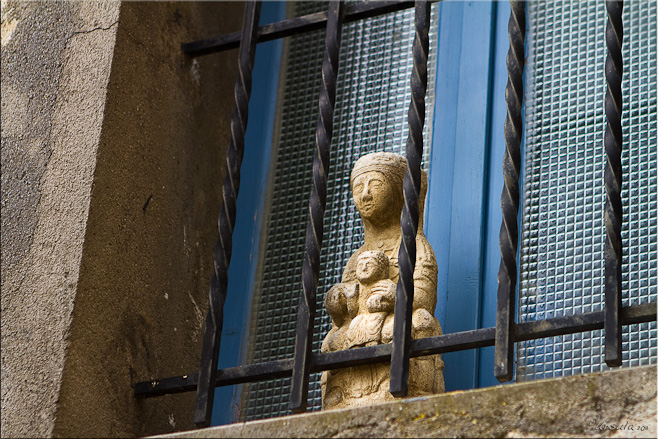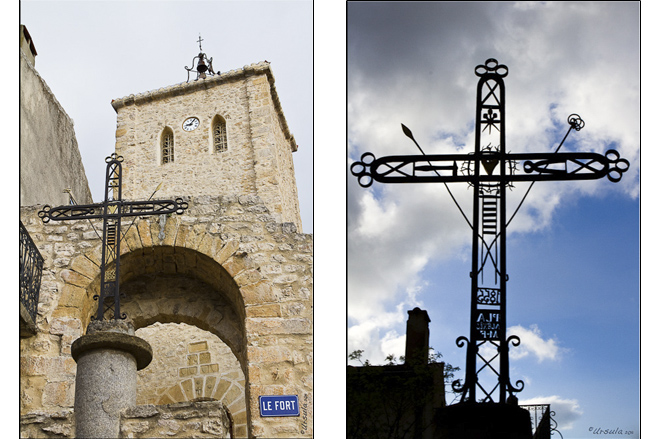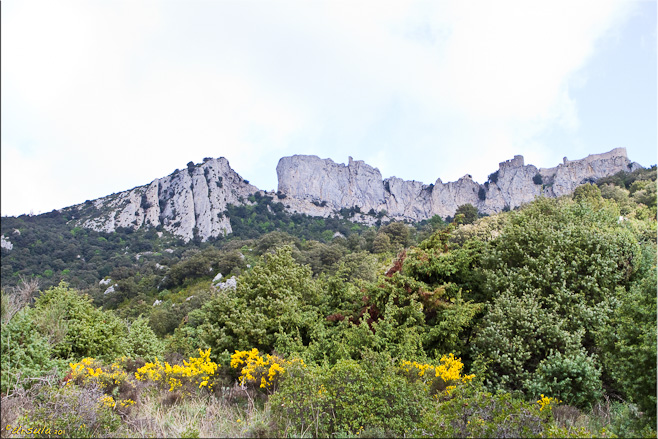
Madonna and Child, L'Église St Michel, Duilhac
Religious expression, or more precisely, the expression of the Roman Catholic faith, is in evidence everywhere in France. Every town has at least one church, with a bell and a cross. On our recent walk along the Cathar Trail, we came across crucifixes, large and small, at every turn.

The Ancient Fortified Centre is the Heart of the Village ~ The Iron Mission Cross (1855) ~ Duilhac
Of course, religious expression is not always peaceful – there is often an uncomfortable tension between war and worship. The images above are from the small town of Duilhac-sous-Peyrepertuse, which as the name suggests, sits under (sous) the ruined fortress of Peyrepertuse. Called a Châteaux cathares (Cathar castle), Peyrepertuse was a temporary haven for the persecuted Cathars during the Albigensian Crusade in the early 1200s, and so stands as a symbol of their eradiacation in the name of religion. Another of the «cinq fils de Carcassonne», the ’Five Sons of Carcassonne’, the Château de Peyrepertuse was originally built by the kings of Aragon in the 11th Century as part of their border defence system.
The climb to the magnificent 800 meter-high ruins was to be the high point (pardon the pun!) of Day Three of our ‘randonnée pyrénéenne’.
Trip Notes: Day 3: Duilhac to Cubières sur Cinoble
We walk up to the Château of Peyrepertuse, through the unforgettable Galamus Gorges and continue to Cubières sur Cinoble to overnight at the Accueil au Village.
Points of interest: Peyrepertuse Fortress, Galamus Gorges, St Antoine de Galamus Hermitage, and Cubières Village.
15 kms. 5 hrs. Altitude gain/descent: +250m -340m
The trip notes make the day sound like a walk in the park. We thought we’d have a relatively easy time of it for two reasons: 1) unlike the day of our last visit in 2008, there was no sign of rain; and 2) our walk to Cubière would be 4km shorter than the walk to Bouchard, which we had done two years earlier. However, the time, distance and altitude estimates in the notes don’t include the steep walk up to the castle and back or the time spent exploring the extensive ruins.

Peyrepertuse ~ "Citadelle du Vertige" ~ Citadel of Vertigo

From a Single Acorn...

Snails on the Hill

Spring Holly

Road into Peyrepertuse
The young English couple walking the same direction as us asked if the ruins were worth the extra work, to which my answer was an emphatic “yes!” I’m not alone in thinking Peyrepertuse is one of the most beautiful of the Corbière castles. The ruins, blending into the landscape like an organic outgrowth, are spectacularly situated on the rocky bluffs of the Upper Corbières. It is no wonder these fortresses were considered impregnable; although this one has been bought and sold by rulers and kings, it has never been successfully assailed. Walking over the grounds, I couldn’t help but marvel in awe at what people were able to build and wonder at how difficult life must have been here in the Middle Ages.

"Peyrepertuse": From the Ancient Occitan for "Pierre Percée" or Pierced Rock

Arched Stone Entry to the Castle of Peyrepertuse

Inside Peyrepertuse

Le Bas-Château / The Lower Castle Resembling the Prow of a Ship, Dates to the 11th Century
As amazing as Peyrepertuse is, I find it discouraging to descend from it, tired, sore and wind-blown, only to realise that it is already well past noon and we still have most of our 15km walk in front of us!
We battled winds for an hour before finding sufficient shelter to allow us a lunch stop, and then continued through farmlands, grasslands and forests before reaching the highway that would take us to Galamus Gorges.

Flowers on the Trail

More Spring Holly

"Here's looking at you, kid!" A calf eyes me on Col de la Corbasse.
It was late afternoon when we reached the start of Galamus Gorges and the parking lot for visitors, and it was tempting to by-pass it rather than walk the extra descent and ascent in and out of the gorge to visit the Hermitage.

The Hermitage of Galamus was built in the 15th Century by the Franciscans in Honour of Saint Antoine, the Founder of Christian Monastic Traditions
But, the descent is worth it. The Hermitage was open and the hermit, though reclusive, was in. We visited the chapel, with its tributes to Saint Antoine, the first Christian hermit (born 251 in Egypt), and bought “hermit cookies”, made by hand with tasty lemon zest by the current resident-caretaker of the site, before tunnelling through the mountain and climbing up to re-join the long, narrow, windy road along the gorge itself.

"Merci" ~ "Thank You" ~ Thanks Given to Saint Antoine the Hermit

Every Hermitage a Bell! Galamus Hermitage.

"Le Christ et L'Humanité" ~ Christ and the People ~ Galamus

Hold onto your Hat! Walking up the Gorge is as Risky as it is Windy. Cars Hope not to Meet any Oncoming Traffic as they can Barely Pass.

Like a Fairy Tale ~ Horses in a Field Outside Cubières sur Cinoble.

Once we crossed a bridge out of the gorge and saw horses in a field of apple and cherry blossom, we knew we were almost ‘home’ for the night. Our evening glass of muscat could not be far away! Like horses sensing the barn, we picked up our pace, found our accommodation, and looked forward to drinks and stories over the dinner table.
‘Till next time, à votre santé ~ to your health!























.jpg)


Your commentary comes alive. Well done
WOW… what an amazing journey, somewhat magical, except perhaps for that road, walking albeit steep still sounds better than trying to pass another vehicle. I am constantly amazed at the places they put dwellings and castles… between rocks, on edges of mountains… and of course the workmanship, although it appears they didn’t haveto look far for rocks ;-D
Yes – no shortage of rocks!
Many thanks for the comments. 😀